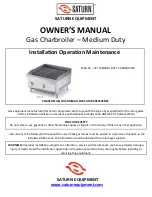
System Design Considerations
6
System Design Considerations
The Vitogas 050 is designed for closed loop,
forced circulation hot water heating systems
only.
Boiler selection
The boiler model size should be based on an
accurate heat loss calculation of the
building. The boiler selected must be
compatible with the connected radiation.
Venting
The Vitogas 050, ECV Series boiler must be
vented with
AL 29-4C
3” or 4” (depending
on maximum equivalent vent length
required) stainless steel rigid positive
pressure vent pipe. Do
not
use any other
venting materials.
The boiler must be located so that the vent
length is as short and direct as possible. All
products of combustion must be safely
vented to the outdoors. Do
not
common
vent with any other appliance.
The vent terminal was certified by an
independent testing agency to withstand 40
mph winds. This boiler may not be suitable
for areas with frequent winds above
40 mph. The vent termination should be
located on a wall that is least affected by
prevailing winds. High winds may affect the
boiler operation and/or degrade the exterior
finish of the wall. If wind is a problem, then
steps should be considered to protect the
vent terminal from high winds, such as a
fence or shrub.
Maximum equivalent vent length
The maximum equivalent vent length (for all
ECV Series sizes) is 20 ft. / 6 m of 3” Ø
pipe or 30 ft. / 9 m of 4” Ø pipe. Do
not
exceed the maximum equivalent vent length.
Details of venting instructions are found in
the ECV Series Installation/Service Manual.
To order venting materials, see Price List.
Warranty excerpts
Our warranty does not cover damages
resulting from the following:
– installation or service by unqualified and
not licensed personnel
– corrosion caused by flue gas condensation
due to low boiler water and/or return
water temperatures
– operation with contaminated fill and
supplementary feed water
For detailed warranty information, please
read warranty sheet supplied with product.
Combustion air supply
The boiler must not be located in areas or
rooms where chemicals containing chlorine,
bromine, fluorine, or other corrosive
chemicals are stored. Examples include
refrigerants, bleach, paint, paint thinner, hair
spray, cleaning solvents, water softener
salt, etc. The combustion air must not be
contaminated with the above mentioned, or
other aggressive or corrosive chemicals.
Boiler should never be installed in areas
where excessive dust, high humidity, or risk
of frost exist. Ensure adequate ventilation
and supply of fresh combustion air.
Consult Viessmann with uncertainties in
regard to a suitable boiler installation
location.
This boiler/burner unit needs clean fresh air
for safe operation and must be installed so
that there are provisions for adequate
combustion and ventilation air. For natural
gas or propane, use the “Natural Gas
Installation Code CAN/CSA-B149.1 or
B149.2” (Canada), or “National Fuel Gas
Code ANSI Z223.1” (USA), and/or
provisions of local codes.
The sizing methods outlined in the above
codes must be used when installing a round
duct to supply combustion air from the
outside. Observe local jurisdictional
requirements.
System layout
The boiler water temperature limit is factory
set to 167°F / 75°C.
The boiler water temperature limit can be
increased by altering the adjustable high
limit to increase the supply water
temperature.
To minimize piping losses of the system
however, we recommend that the radiation
and domestic hot water production in the
system be designed for a 158°F / 70°C
boiler supply water temperature (new
systems).
Water quality
Treatment for boiler feed water should be
considered in areas of known problems,
such as where a high mineral content and
hardness exist. In areas where freezing
might occur, an antifreeze may be added to
the system water to protect the system.
Please adhere to the specifications given by
the antifreeze manufacturer. Do not use
automotive silicate based antifreeze. Please
observe that an antifreeze/water mixture
may require a backflow preventer within the
automatic water feed and influence
components such as diaphragm expansion
tanks, radiation, etc. A 40% antifreeze
content will provide freeze-up protection to
-10°F / -23°C. Do
not
use antifreeze other
than specifically made for hot water heating
systems. System also may contain
components which might be negatively
affected by antifreeze. Check total system
frequently when filled with antifreeze.
Advise system operator/ultimate owner that
system is filled with a glycol mix.
The heating contractor must provide an
MSDS (Material Safety Data Sheet) for the
antifreeze used to the system
operator/ultimate owner.
Oxygen diffusion barrier
underfloor tubing
The boiler warranty does not cover leaks
resulting from corrosion caused by the use
of underfloor plastic tubing without an
oxygen diffusion barrier. Such systems must
have the non-oxygen diffusion barrier tubing
separated from the boiler with a heat
exchanger. Viessmann recommends the use
of underfloor plastic tubing with an oxygen
diffusion barrier.
Low water cut-off
A low water cut-off may be required by local
codes. If boiler is installed above the
radiation level, a low water cut-off device of
approved type must be installed in all
instances. An approved type low water
cut-off device must be provided by the
heating contractor. Do not install an
isolation valve between the boiler and the
low water cut-off.
5167
449
v1
.3


























